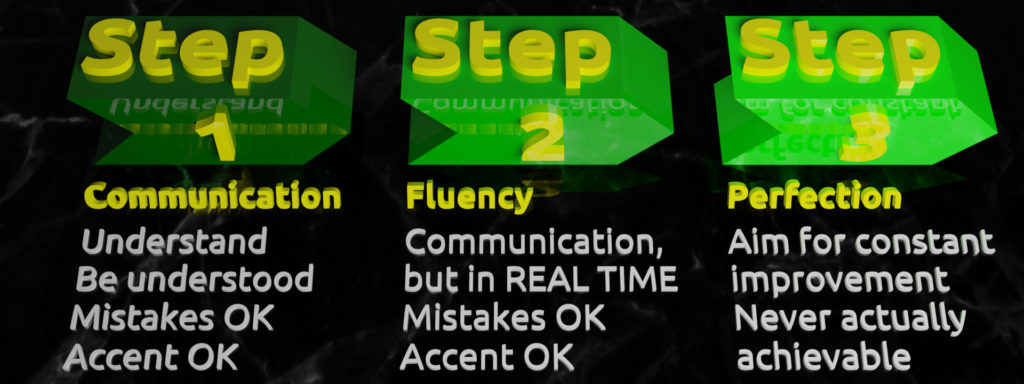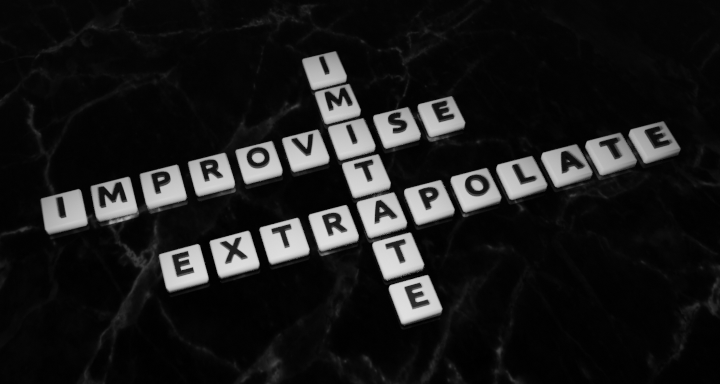For the other posts in this series:
Introduction & Credentials
Practicalities of Learning Languages
Language Teaching Problems I – Possible Causes
Language Teaching Problems II – Symptoms & Side-effects
Curing Language Trauma I – Setting the Stage
Curing Language Trauma II – Working on the Language
Benefits of Learning Languages
Now that I’ve laid out my credentials for discussing language education, let’s address the concrete reality of languages. Yes, languages are an intellectual reality. But the purpose of languages is eminently practical in nature. This we must not forget. Yet in some areas language has become so tightly interwoven with cultural identity that it’s been used, or diverted, by politicians and rulers to serve a rather more ideological purpose. Let’s go beyond this to examine the practicalities of languages, as well as some tips on how best to practice and improve.
First, the Dirty Little Secret
Let’s start with the dirty little secret of languages: no matter how much you practice, how much you learn, how intent and insistent you are on speaking and writing any language absolutely perfectly, this is actually NOT possible. Because whatever the language, it isn’t and, to a large degree, can’t be considered a single truly homogeneous entity. The same language is used in slightly different ways, with slightly different rules, in different locations and at different periods of time.
So the closest anyone can get is perfection according to one specific place and time. Accents vary within the United States, even within individual states. Vocabulary differs between countries and their former colonies, or other countries traditionally of the same language. Dialects exist and influence the actual official languages in their own regions. Despite an ever more globalized population and culture, local influences still come into play in many ways, leading to the creation of region-specific or even city-specific jargon. And the dialect continuum means that foreign languages and cultural spillover from just across a nearby border influence the local language as well, and vice-versa. This gives it new words and expressions and the versions of each language along each border take on their own distinct identities. So keep that in mind as you progress in your own skills, and be realistic as regards your personal objectives.
The Three Steps to Learning a Language
But that perfection caveat doesn’t matter. Because at a really practical level, learning a language can be broken down in a very simple way into three steps, and perfection is not necessary anyway.

Communication
The first and most critical objective when learning a language, because that is its actual main purpose, is to be able to communicate, that is understand what is said and make oneself understood. It’s as simple as that. Having a perfect accent or perfect grammar absolutely doesn’t matter, as long as you get your message across. And in many cases, grammatical, lexical or verbal mistakes aren’t serious enough to corrupt the meaning to the extent of preventing others from getting the meaning.
Fluency
This is the second objective when learning a language. But there’s a common misconception with regards to fluency. Most people, I find, understand fluency to mean absolute perfection at a native-speaker level. But what matters far more is the efficiency of the language. Fluency in any language really only means communication, as described above, but in real time. That’s it. One speaks fluently when the language flows smoothly without hesitations. When one isn’t translating everything in one’s mind before understanding or saying it. When one doesn’t lose time searching for words or expressions. When none of that gets in the way of communicating effectively and efficiently. And here again, a perfect accent, grammar or vocabulary are absolutely NOT critical.
Aiming for perfection
Perfection is not possible, we’ve seen this, which might make my mentioning this seem paradoxical. But one can reach a sufficient degree of perfection to be able to communicate equally well and fluently with anyone, regardless of where they are from, as much as possible without mistakes or accents.
That’s all there is to it, really. And after all, that is how all of us have learned our first languages. However, as we’ll see in the next posts, many educational systems seem to turn this concept on its head, focusing on perfection first and treating communication as an afterthought, as if the reason for learning languages were only to be able to brag about it but never have to use it. And while this may be consistent with some people’s priorities, for everyone else, it causes serious damage.
Simple Tips to Help Practice
But the main thing, once you have a bit of knowledge of a language, is to realize that you can really only go so far with books and apps. They can teach you the words and expressions and grammar, but in order to teach it in as flexible a way as possible they have to focus on disconnected words and expressions. And this won’t help you much when you’re trying to have an actual conversation. The one single way to move on from there is to practice. Only that way will you reach a level where you’re able to communicate. Then, only with more practice will you be able to gain fluency and speak in real time. And after that, only with practice will you be able to approach perfection. Here are my recommendations on how best to practice any language.

Listen and Imitate
One thing we all do and have been doing constantly since the day we were born, is learning by listening – or reading – and imitating. This is crucial to languages in particular, because what you have to learn is exactly what people use with you in the first place. This listening and imitating process is one we all do without thinking anyway. We listen to the same correct things over and over again, until little by little, by osmosis, it just gets in and we say it right. We adjust progressively, making an effort here with the infamous German “ch” from the back of the throat, the Turkish “ö” and “ü”, the Portuguese nasalized vowels, the South African dialects’ clicks…
What I always recommend people do is do the same thing, but consciously. Instead of just nailing it after 300 random tries, pay attention to what you’re listening to and make an effort to adjust your language deliberately and consciously. That way you will zero in on the correct way of saying it much more quickly! This isn’t a paradigm shift or anything, it’s just doing something we already naturally do, but in full awareness that that’s what we’re doing, and actively learning instead of just letting it slowly seep in.
Improvise and Guess
Most languages are related to some degree, but this is more particularly the case with the most commonly learned languages in the world. And wherever in the world you are, historical trade and cultural exchange will usually have led to some inheriting or borrowing between regional languages. If you’re learning a language with some links to your own, and you observe enough of both of them, you will likely pick up what similarities exist between them. And what’s more, you can use those to your advantage!
For example, Spanish and Portuguese come from much the same roots, though they have evolved differently in the 900 years since the countries parted ways. Still today, the languages are close, to the point that Portuguese people have no trouble understanding Spaniards and Spaniards have little (though admittedly some) trouble understanding the Portuguese. The reason? The two languages have a full 90% of words in common!
Say you’re Spanish and learning Portuguese. You know the word “comunicación” in Spanish. And you know “acción” and “población” too, and you’ve seen their Portuguese equivalents are “acção” and “povoação”, and that this rule seems to hold for many more words ending in “-ción”. So you can perfectly well take a guess and try to use “comunicação”, just in case. And 9 times out of 10, you will be absolutely right. This helps you learn more words and expressions that you can use in the language, which immediately greatly increases your vocabulary above and beyond what you officially know.
Of course, this is by no means 100% accurate. Remember, in this example, only 90% of the words are in common. Once in an email in Portuguese I tried to use “recordatório” to say “reminder”, and this was directly inspired by the Spanish equivalent “recordatorio”. As it happens, the word exists in Portuguese, but only in a very specific sense, and the people I wrote to didn’t know it. It turns out the Portuguese word for this is “lembrete”. So yes, false friends mean that sometimes you won’t get it right, but these mistakes and what you learn from them will be just as useful, and the number of guesses that work sometimes vastly outnumber those that don’t.
This can also work with unrelated languages, but with some small adjustments: you need to improvise not from the equivalent form in your own language, but from a different form of the same word in the language you’re learning. For example, if you know the German verb “to move” (bewegen sich) and you’re trying to describe a “movement” with a noun, you can try to use something you know, the connection between “to investigate” (untersuchen) and “investigation” (Untersuchung) to improvise “Bewegung”.
Put it in Context and Extrapolate
But, I’ve said it before, by far the best way to truly learn a language is to practice it in actual conversation. It’s all well and good to repeat, translate, read and write the same disconnected sentences over and over again, but if the words, expressions, grammatical structures etc. aren’t part of a true conversation, text or story, you won’t be able to be flexible and use them in whatever random situation turns up. You need to find as many opportunities as you can to actually use what you learn in a real context. Find people to practice with, using apps such as Tandem and iTalki. Find local language exchange meetings with apps like Meetup. Travel onsite and talk to the locals, stay and interact with them if you can, with apps such as CouchSurfing.
But barring all that, there is another way you can put this all into context. Get access to content you already know well in another language, but this time in the language you’re learning. As you follow along, you’ll understand only a certain percentage of it. But that doesn’t matter, as you already know the story anyway. And what you don’t understand, you can extrapolate much more easily. For example, if Italian-speaking Frodo Baggins says, “Sai, alcuni si fanno delle domande su di te, zio” and you don’t understand “domande”, you know enough to realize he’s talking about how others are wondering about his uncle Bilbo, asking “questions”. This can help you guess that what you hear, “domande”, is the word for “questions”.
We have to stop seeing language as a purely academic thing, good for nothing more than social status or to show off. Its very objective is eminently practical. Even the study of the dead classical languages, much more of a niche area in itself, is put to practical purposes, to study classical texts. We need to remember this and approach teaching languages in a pragmatic way, focusing on putting it in use in the best possible circumstances. Unfortunately, as we’ll see in the next post, various influences lead to some systems teaching languages in a very backwards way.

6 thoughts on “The Practicalities of Learning Languages”